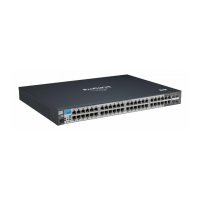6-22
Configuring Secure Shell (SSH)
Further Information on SSH Client Public-Key Authentication
6. Use an SSH Client To Access the Switch
Test the SSH configuration on the switch to ensure that you have achieved the
level of SSH operation you want for the switch. If you have problems, refer to
"RADIUS-Related Problems" in the Troubleshooting chapter of the Manage-
ment and Configuration Guide for your switch.
Further Information on SSH Client
Public-Key Authentication
The section titled “5. Configure the Switch for SSH Authentication” on page
6-18 lists the steps for configuring SSH authentication on the switch. However,
if you are new to SSH or need more details on client public-key authentication,
this section may be helpful.
When configured for SSH operation, the switch automatically attempts to use
its own host public-key to authenticate itself to SSH clients. To provide the
optional, opposite service—client public-key authentication to the switch—
you can configure the switch to store up to ten RSA or DSA public keys for
authenticating clients. This requires storing an ASCII version of each client’s
public key (without babble conversion, or fingerprint conversion) in a client
public-key file that you create and TFTP-copy to the switch. In this case, only
clients that have a private key corresponding to one of the stored public keys
can gain access to the switch using SSH. That is, if you use this feature, only
the clients whose public keys are in the client public-key file you store on
the switch will have SSH access to the switch over the network. If you do not
allow secondary SSH login (Operator) access via local password, then the
switch will refuse other SSH clients.
SSH clients that support client public-key authentication normally provide a
utility to generate a key pair. The private key is usually stored in a password-
protected file on the local host; the public key is stored in another file and is
not protected.
(Note that even without using client public-key authentication, you can still
require authentication from whoever attempts to access the switch from an
SSH client— by employing the local username/password, TACACS+, or
RADIUS features. Refer to “5. Configure the Switch for SSH Authentication”
on page 6-18.)

